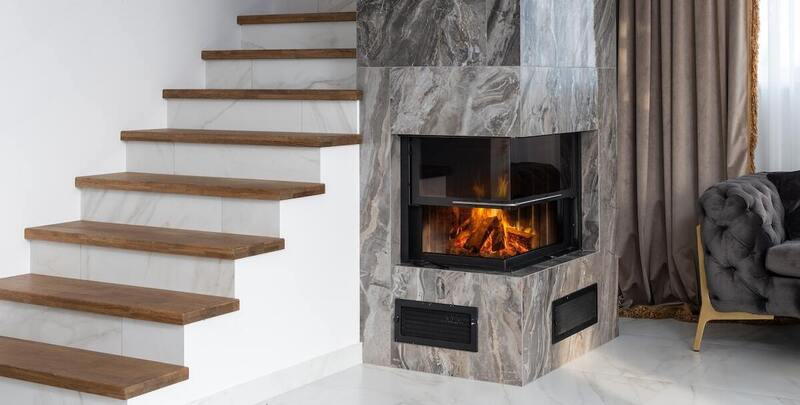
What You Need to Know About Your Gas Log Fireplace
It’s hard to beat a gas log fireplace when you want to warm up your main living space and create a cosy atmosphere as the temperature drops outside.
There’s no doubt that modern gas fireplaces look great and keep winter’s chill out, but there are a lot of other benefits as well. There are also a number of factors to consider if you want to get the best performance out of your gas log fireplace.
You might already have a gas unit or perhaps you’re currently in the process of deciding whether or not to install a gas log fireplace. The following details might help you make up your mind if a gas log fire is the right style of heating for you.
How Long Have Gas Fireplaces Been Around?
Gas log fireplaces have been around for more than 160 years. The first commercial gas fireplace model appeared on the market in the mid-1850s. The earliest versions of gas log fireplaces were stand alone, portable gas heaters.
By the 1920s it was a popular alternative to a wood burning fireplace. With the invention of the convector fire in the 1950s, the gas fireplace became recognised as being more efficient and better for the environment, due to natural gas emitting fewer by-products.
A Gas Log Fireplace is Convenient
If you enjoy the ambience of a traditional fireplace but don’t want the hassles of the wood fireplaces, then gas log fires are for you.
Compare a gas log fire to an open fire using wood. You are saved all the hassle of buying, storing, chopping or carrying wood, and you don’t have to sweep out the fireplace. You can even have a gas fires installed in an existing fireplace. It’s a cleaner system than a wood burning fireplace and no smoke ever gets into the house, making the indoor air quality better and healthier.
With the energy efficiency of a gas log fireplace, you get instant warmth at the push of a button. The alternative? Gathering wood and creating a spark for a wood heater. You can even use a remote control or a timer for convenient gas heating. And the heat can be turned off just as quickly. You get realistic flames, and the only thing missing is the crackling sound.
There is less maintenance and cleaning than traditional wood fireplaces, other than a quick clean perhaps once a month. It is also wise to have gas appliances serviced annually by a professional gas fitter.
They will thoroughly check all key components, including the gas burner, thermostat, fan, venting and pilot light. This will ensure the gas fireplace is working to its maximum capacity and venting properly so it is not leaking any byproducts (such as carbon monoxide) into your home.
In-built gas fireplaces can be retrofitted to an existing wood burning fireplace or installed on the wall of your choice. However, gas fireplace installations may be more expensive if there is no chimney in place.
Benefits of Freestanding Gas Heaters
These stand alone gas log heaters are available in a range of sizes and designs. A freestanding gas log fireplace radiates heat from all sides and can warm a room quickly.
This style of gas heater is easy to install and maintain. They are available in flued or unflued options, but an unflued freestanding gas heater should only be used outdoors where any carbon monoxide emissions and other by-products can be released into the outdoor air.
Using an unflued heater inside can risk carbon monoxide poisoning, which can be fatal. However, vent-free technology has advanced, so keep reading to discover more.

You Have Two Fuel Choices
There are two types of gas used to fuel modern gas log fireplaces. It’s important to know the difference between them.
- Natural gas – While natural gas is harmful to the atmosphere in its raw form, it is a clean-burning and cost-effective fuel that is not as volatile as the alternative, liquefied petroleum gas (LPG). It also dissipates in air and is less likely to form dangerous pools if gas leaks occur. If you do not have an existing gas connection there will be additional costs for installation. Be sure to check with local gas suppliers to determine what expenses you will face.
- LPG – This type of fuel results as a by-product during the processing of natural gas. It condenses into liquid form when stored under pressure and is far more volatile than natural gas. You will need to install an LPG tank outside of your home. Regular gas refills will be required.
You Have a Choice of Venting Options
You essentially have four types of venting options to choose from that don’t require a chimney. Vented systems are preferable but there have been advances to vent free gas logs.
- Direct vent – This is the safest choice because it throws out combustion fumes and pollutants through a small hole in the exterior wall (or a chimney).
- Natural venting – A natural vent (or B vent) draws air for combustion and gets rid of exhaust fumes via a venting system (or chimney) going through the roof.
- Power venting – This option uses a fixture powered by a fan which pushes unwanted exhaust fumes out of the home through vents.
- Vent-free fireplace – This is the most flexible type of gas fireplace. Some exhaust fumes will be released into your home, although it is generally considered safe. This may prove damaging in small rooms or poorly vented spaces. Some models come with a carbon monoxide monitor but it’s recommended to have a second monitor.
Vent-free technology is now much safer and has advanced considerably, according to Lennox Hearth Products development director Robert Dischner on the Bob Vila home advice website. “The fireplaces use catalytic-converter technology,” he said. “Because of this technology, no chimney or venting is required.”
The Final Word on Gas Log Fireplaces
To wrap it up, gas fireplaces are stylish, versatile, efficient and clean. Gas fireplaces are more eco-friendly and safer than burning wood. If you want a heater that looks good and, most importantly, keeps you toasty warm in winter, it’s hard to go past a gas log fireplace.
For more information on gas log fireplaces, contact the heating and cooling experts at Metropolitan Air Conditioning today.
Please note: This information is provided for advice purposes only. Regulations differ from state to state, so please consult your local authorities or an industry professional before proceeding with any work. See our Terms & Conditions here.
Published: 2022-08-18

































